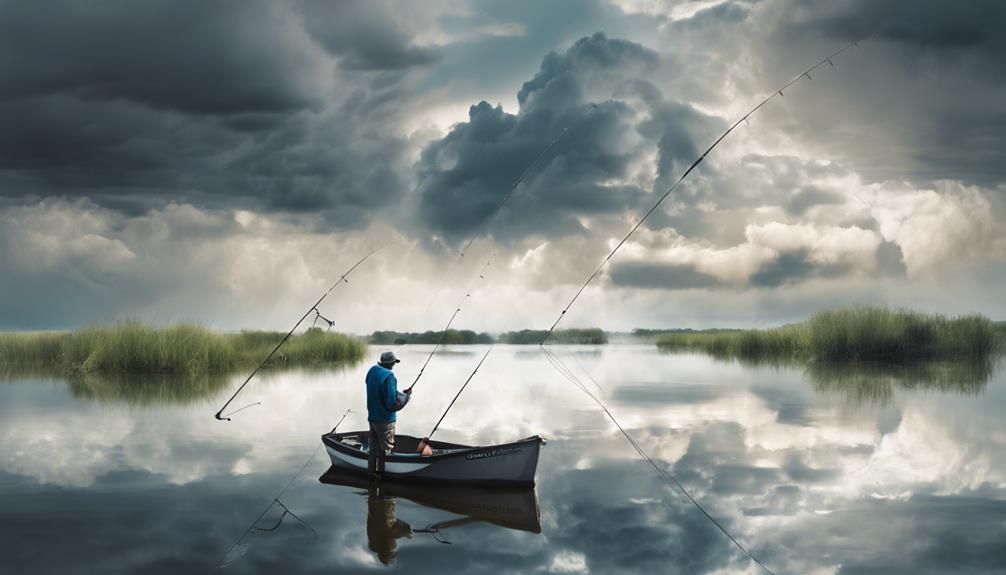Temperature fluctuations, barometric pressure changes, wind patterns, and precipitation events all affect fish feeding behaviors. When water temperature shifts, fish metabolism changes, impacting their energy needs and food preferences. Barometric pressure variations influence fish activity levels, with trends aiding in predicting feeding times. Wind patterns alter current directions, water clarity, and oxygen levels, affecting baitfish movements and feeding strategies. Precipitation events increase water oxygenation, disturb surfaces making prey easier targets, and boost aquatic insect activity. Understanding these factors is crucial for successful fishing expeditions, as they play a significant role in fish feeding patterns and behaviors.
Temperature Fluctuations
Temperature fluctuations directly impact the feeding behavior of fish in aquatic ecosystems. Fish are ectothermic, meaning their body temperature is influenced by the surrounding environment. As the water temperature changes, so does their metabolic rate. This metabolic rate is crucial as it affects how much food a fish needs to consume to maintain its energy levels.
When the water temperature rises, fish tend to have higher metabolic rates. This increase in metabolic rate leads to an increase in the fish's overall energy requirements. Consequently, fish may need to feed more frequently or consume larger quantities of food to meet their energy needs. On the other hand, when the water temperature drops, fish experience a decrease in metabolic rate. This decrease in metabolic rate results in reduced energy requirements, leading to a decrease in feeding behavior.
Studies have shown that temperature fluctuations not only affect the frequency of feeding but also impact the types of food fish prefer. For example, during warmer periods, fish may be more active and inclined to feed on smaller prey items that require higher energy expenditure to catch. Conversely, in colder temperatures, fish may opt for larger, more energy-rich prey to sustain themselves with minimal effort. Understanding these nuances in fish feeding behavior can provide valuable insights for fisheries management and conservation efforts in the face of changing environmental conditions.
Barometric Pressure Changes
Barometric pressure changes influence fish feeding behavior by exerting pressure variations that can impact their physiological processes and feeding patterns. Fish are sensitive to changes in barometric pressure, which refers to the weight of the atmosphere pressing down on the Earth's surface. When the barometric pressure is high, fish tend to be more active and feed actively near the surface. Conversely, when the pressure drops, fish may move to deeper waters or become less active, affecting their feeding behavior.
Understanding how fish behavior is influenced by barometric pressure changes is crucial for anglers. When the pressure is high, fishing techniques like topwater lures or surface baits can be more effective as fish are more likely to be feeding near the top. On the other hand, when the pressure is low, using sinking baits or fishing deeper waters may yield better results. Monitoring barometric pressure trends can help anglers predict fish activity levels and adjust their fishing strategies accordingly.
Wind Patterns
Wind patterns play a significant role in influencing fish behavior and feeding habits. The direction of the current influences the movement of baitfish, which in turn affects the predatory fish following them. When the wind pushes the surface water in a particular direction, it creates a current that carries nutrients and plankton, attracting baitfish. Understanding these current directions can help anglers position themselves strategically to increase their chances of a successful catch.
Moreover, wind patterns affect water clarity. Strong winds can stir up sediment and debris, reducing visibility underwater. This decrease in water clarity can make it harder for fish to locate prey visually, impacting their feeding behavior. Additionally, changes in wind patterns can lead to fluctuations in oxygen levels. Wind-induced currents help in oxygenating the water, which is crucial for fish survival. However, excessive wind can also cause turbulent conditions, disrupting the natural distribution of oxygen and affecting fish feeding patterns.
In relation to wind patterns, wave intensity is another key factor that influences fish behavior. Strong winds create larger waves, which can disorient fish and make it challenging for them to feed effectively. Fish may seek calmer waters or adjust their feeding strategies in response to the intensity of the waves. Therefore, paying attention to wind patterns and their effects on current directions, water clarity, oxygen levels, and wave intensity is essential for successful fishing.
Precipitation Events
During precipitation events, the influx of rain or snow can have a profound impact on fish behavior and feeding patterns. When it rains or snows, the aquatic environment experiences significant changes that directly influence how fish interact with their surroundings and search for food. Understanding the rainfall impact on feeding behavior is crucial for anglers and researchers alike.
Here are four key ways in which precipitation events affect fish feeding behavior:
- Increased Oxygen Levels: Rainfall helps aerate the water, increasing oxygen levels. This oxygen boost can stimulate fish activity and feeding, especially in oxygen-deprived areas.
- Surface Disruption: Raindrops hitting the water surface create ripples and disturbances. These disruptions can disorient small insects or other prey, making them easier targets for fish.
- Nutrient Wash-off: Rainfall washes nutrients from the land into the water. This influx of nutrients can lead to an increase in aquatic insect activity, providing fish with more feeding opportunities.
- Water Clarity Changes: Heavy rainfall can muddy the water by stirring up sediment. In murky conditions, fish may rely more on their lateral lines and senses rather than sight to locate food.
Frequently Asked Questions
How Do Fish React to Sudden Changes in Weather Conditions?
When sudden weather changes occur, fish behavior can be influenced significantly. These shifts can impact their feeding patterns, causing them to either become more active or retreat to sheltered areas.
Sudden drops in temperature may slow down fish metabolism, leading to reduced feeding activity, while rapid changes in barometric pressure can trigger fish to feed more aggressively.
Understanding how fish react to these weather variations is crucial for successful angling.
Can Fish Feeding Habits Be Influenced by Humidity Levels?
Humidity impact on fish feeding behavior is a crucial factor to consider. Changes in humidity levels can affect fish metabolism, leading to alterations in their feeding patterns. High humidity may reduce fish activity and appetite, while low humidity can stimulate feeding behavior.
Understanding how humidity influences fish feeding habits is essential for effective fisheries management and aquaculture practices. This relationship highlights the intricate balance between environmental conditions and fish behavior.
Do Different Fish Species Have Unique Responses to Weather?
Different fish species exhibit variations in their responses to weather conditions. These behavioral adaptations are often influenced by specific environmental factors.
Understanding how different species react to changes in the weather can provide valuable insights into their feeding habits and overall survival strategies.
Are Moon Phases Linked to Fish Feeding Behavior During Weather Changes?
During weather changes, lunar cycles can influence fish behavior. Research suggests that moon phases can impact feeding patterns in various fish species.
Understanding this connection between lunar cycles and fish behavior can provide valuable insights for predicting feeding behavior during specific weather patterns.
How Does the Intensity of Sunlight Impact Fish Feeding Patterns?
When the intensity of sunlight changes, it affects fish feeding patterns. The impact of shadows cast by varying solar radiation levels can alter feeding behavior.
Fish may adjust their feeding locations and activity levels based on how sunlight penetrates the water. Higher solar radiation levels can lead to increased visibility for predators and prey, influencing feeding decisions.
Understanding these dynamics is crucial in predicting and managing fish populations in changing environmental conditions.
Conclusion
In conclusion, the feeding behavior of fish is greatly influenced by various weather factors. Temperature fluctuations, barometric pressure changes, wind patterns, and precipitation events all play a significant role in determining when and where fish will feed. Understanding these factors can help anglers and researchers alike predict fish activity and improve their chances of a successful catch.
By closely monitoring weather conditions, one can maximize their fishing opportunities and potentially increase their success rate.



